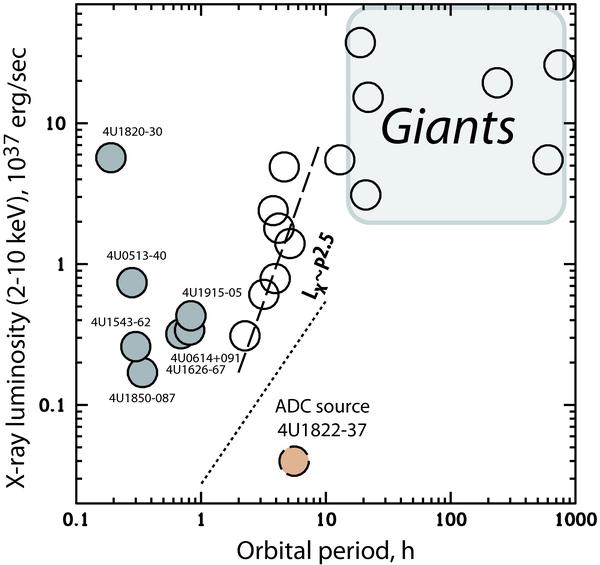Fig. 1

Positions of the LMXBs from Table 1 on the orbital period – X-ray luminosity diagram. Filled circles denote the positions of peculiar systems: grey circles show the positions of binaries with white dwarf or hydrogen-deficit accretors, and the dashed circle shows the position of 4U1822-37 in which we see only a fraction of the total X-ray luminosity due to its nearly edge-on orientation (a so-called accretion disk corona source). The region, occupied by binary systems with a giant donor is shown by the shaded square. The dashed line shows the slope Lx ∝ P2.5 derived by Iben & Tutukov (1984) for the mass transfer rate in binaries in which angular momentum loss is driven by a magnetic stellar wind from a main-sequence donor. The dotted line shows the boundary of persistency according to the thermal-viscous disk instability for binaries with low-mass main-sequence donors Lx/1037 erg/s  from Eq. (32) of Dubus et al. (1999), where we adopted M1 = 1.4 M⊙, M2 = 0.4 M⊙, and Lx = 0.1 Ṁc2.
from Eq. (32) of Dubus et al. (1999), where we adopted M1 = 1.4 M⊙, M2 = 0.4 M⊙, and Lx = 0.1 Ṁc2.
Current usage metrics show cumulative count of Article Views (full-text article views including HTML views, PDF and ePub downloads, according to the available data) and Abstracts Views on Vision4Press platform.
Data correspond to usage on the plateform after 2015. The current usage metrics is available 48-96 hours after online publication and is updated daily on week days.
Initial download of the metrics may take a while.


